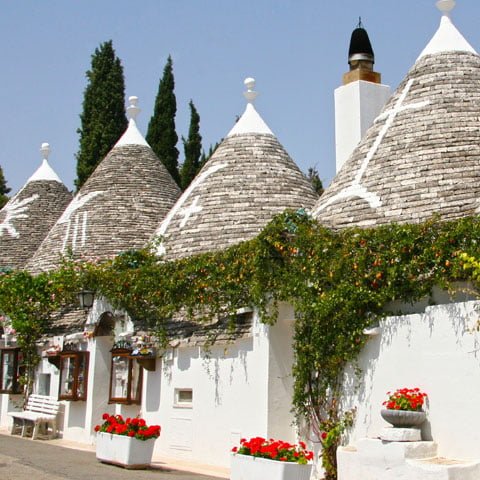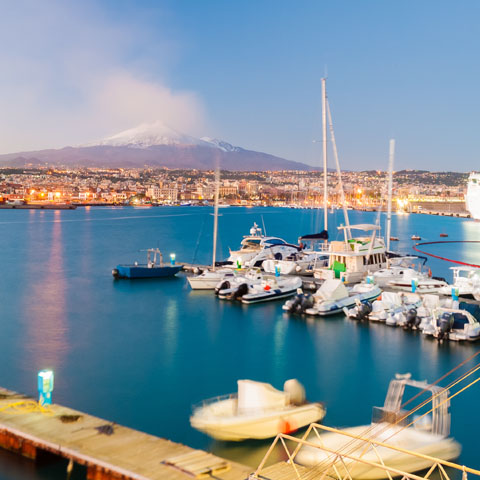Apulia - History
Apulia stretches along the Adriatic Sea, and it is almost completely surrounded by water. The large coastline and marine environments have always represented an entrance for the merchants and traders from the East.
In fact, since the Roman Age, the region constituted a bridge between the peninsula and the East. Moreover, the region kept its status over time and the main Adriatic ports located in Bari, Otranto, and Brindisi, still serve as a gate to Albania, Turkey, and Greece.
From a naturalistic point of view, Apulia is a particular region and its singularity has attracted many populations over the years. The characteristics of the region include the uniqueness of the territory formed by karst limestone, steep slopes and a lack of surface hydrography.
From the time of the Ancient Romans through the middle of the 19th century, Apulia was divided into three territorial units. Today the region is consists of six administrative provinces.
Prehistory of Apulia
Among all Italian regions, Apulia is perhaps one of the most well-known for the variety of its environments and demographic intensity as far as the prehistoric populations are concerned. The oldest lithic complexes in the region belong to the Lower Paleolithic and are mostly concentrated in the Gargano area.
Ancient settlements have been discovered belonging to the Acheulean population, while the Umbra Forest contains numerous artifacts and testimonies of ancient civilizations.
Other facets of the prehistoric colonization of the region are present in areas of Gargano, such as a series of sites in Forchione. Of particular importance are the lower levels of the outer cave shelter Paglicci that contains numerous artifacts belonging to the Acheulean civilization. Some sites have an uncertain attribution, such as the upper cave in Otranto. In the Otranto area, important findings are located in the Romanelli Cave and are related to the oldest stage of the Mousterian Age in Apulia.
This limestone complex revealed several findings related to the final stage of the Acheulean Era, particularly from the Caves of Uluzzo and Paglicci. A particular aspect of the Mousterian Age in Apulia is given by the use of the caves and grottos for the preparation of instruments. These caves, namely the caves of Uluzzo and Serra Cicora near Lecce, are very similar to other caves located in Lazio and Liguria.
One of the most important findings from prehistory is a Neanderthal human female found in the Mousterian deposits in the Cave of Santa Croce near Bari.
The archaic phases of the Upper Paleolithic are very well attested, particularly in the caves and caverns of Uluzzo, Serra Cicora and Torre Testa, but also in the Umbra Forest and in other locations in the provinces of Foggia and Bari.
Apulia is also rich in evidence belonging to the Gravettian and Epigravettian Eras. Some burial sites were found in the Gravettian and Epigravettian layers and contain important examples of mural art representing animals and other engravings with diverse meanings.
Apulia is one of the few Italian regions rich in findings belonging to the ancient Neolithic, including an imprinted ceramic culture found in various prehistoric sites such as Francavilla Fontana, Molfetta, the Tremiti Islands, and other centers.
Other findings belonging to the Neolithic are located in caves throughout the territory, including the Scaloria Cave and a few other caves in the areas of Ostuni and Molfetta. Masseria La Quercia, the Cave of Zinzulusa, Marina di Novaglie and the Cave of Porto Badisco are additional sites of exceptional interest due to the preserved paintings they hold.
The major cultural innovations characteristic of the Eneolithic period are attested by the presence of graves and tombs. Some of the most important sites are those in Cellino San Marco and Laterza, although there are many other noteworthy sites in the region.
Last but not least, the prehistory of the region is also attested to in the many findings that show the existence of the relations with the Aegean world, which developed in the middle and late Bronze Age. Some important coastal dwellings, such as the Castelluccia Tower, had been erected in those times, while the remains of fortifications and findings belonging to the Mycenaean civilization prove the existence of a blooming society.
History of Apulia
Apulia shaped its identity under the Mycenaean influence since the sixteenth century BC. This influence led to major socioeconomic changes in the region that concluded with the affirmation of large communities, articulated forms of territorial divisions, and a stable work environment.
In the twelfth century BC, the region was affected by numerous political perturbations linked to the arrival of the Illyrian populations. These changes concluded with the founding of Taranto in the eighth century BC and resumed with the formation of relationships with the Aegean world, which acted throughout the south of the peninsula as a true colonial phenomenon.
To cope with the increasing pressure from the Italic populations, in the fourth century BC Taranto became the promoter of the Italian League. The Romans entered Apulia at the end of the same century, and in a short time registered numerous victories including those in Sentino in 295 BC and in Benevento in 275 BC. The conquest of the region by Rome became definitive after the defeat of Hannibal in the Second Punic War.
Involved in the Social War between 91 and 87 BC and in subsequent other wars, Apulia, including the area of Vulture (Basilicata) and a part of Molise, became the second region in Italy according to the division of Augustus.
In the First Imperial Age, thanks to the development of agriculture and more specifically to the cultivation of grains and olives, as well as to the fertile land and transient breeding, the region started to enjoy a high level of well-being and the emergence of a strong rural aristocracy.
Taranto, although deprived of its ancient role as a metropolis, continued to thrive. In the third century BC, the administrative and fiscal reforms implemented by Diocletian led to a gradual abandonment of the cities and to the formation of almost self-contained economic, political, and social centers in many areas of the region.
From 552 AD, the Byzantines, following the Goths, extended their sovereignty over Apulia and Calabria, especially in the area of Salento. The Byzantine Empire ruled the region until the seventh century AD, when the region witnessed the constant expansion of the Longobards who relegated the Byzantines to Salento.
In the ninth century, most of the coast fell under the control of the Saracens who established their capital in Bari. Only in 871 a vast coalition between the Imperial, Longobard and Byzantine forces, supported by the Venetian army, succeeded in defeating the Saracens, to the subsequent benefit of the Byzantines who restored their domination over the region.
The various administrations of the main centers of Apulia combatted several times against the Byzantine domination, the most notorious rebellion being the one promoted by the Longobards in Bari in 1016. The rebellion was supported by Norman mercenaries who created the County of Melfi, entrusting it to William the Iron Arm in 1043, and prevailing over the Byzantines.
In the time of Roberto Guiscardo, the cities of Apulia maintained a great autonomy, and Guiscardo obtained in 1059 the title of Duke of Calabria and Apulia. The Norman hegemony was repeatedly questioned, not only by the people, but also by the Pope and Emperor. On the other hand, Roger II, who became Duke of Apulia in 1128, had to recognize more liberties and privileges under the pressure made by the city of Bari.
Nevertheless, in the period of Norman domination, Apulia, overlooking the merchant routes to the East, met a discreet economic development. After the destruction of Bari in 1156, the people rebelled again against the Normans and the region shared the troubled sorrows of the Norman crown, first in the clash against the Byzantines, and then against the Saracens.
In 1194 Apulia was passed to the Swabians and under Frederick II it became a privileged area governed by a large and active bureaucracy.
With the advent of the Anjou in 1268, the weight of the feudal regime increased and many lands and cities were shared with the French Lords. During this time, the Genoese, Florentine, and Venetian bankers established a strong control over the agricultural production of Apulia.
Between the fourteenth and fifteenth centuries, the Anjou started to struggle against the Aragonese. The conflicts culminated with revolts against the great feudal lords, and the Venetian pressure on the coastal areas and the ports brought a climate of anarchy in the region.
The advent of Aragon in 1442 did not bring any significant changes and most of the territory remained under the feudal jurisdiction, while the control of the crown was limited to the traditional monopoly over salt, iron, and silk.
The transhumant breeding became a constant in the culture of Apulia, and in 1447 the Customs Administration of the Sheep Tracks was established.
In the sixteenth century, under Spanish rule, the region was divided into three administrative units that remained unchanged over time. The units, namely Capitanata, Terra di Bari and Terra di Otranto, laid the economic bases that corresponded to the needs of Spain.
Apulia was strongly affected by the economic crisis in the seventeenth century and it only recovered during the Hapsburg period, thanks to the resumption of traffic in the Adriatic.
The advent of the Bourbon dynasty in 1734 laid the foundation for the deployment of the new social forces. The confrontation between the feudal nobility, the patrician citizens and the bourgeois quarters led to further economic instability in the region.
Nevertheless, the eighteenth century witnessed a widespread expansion of the cereal crops, mainly in the towns controlled by the feudal aristocracy. This expansion was accompanied by the consolidation of the rural farm estates, called "masserie" by the locals.
During a brief Republican period, the region witnessed a clash between the minority of bourgeois and a reactionary popular majority which was actively supported by Cardinal Ruffo’s army.
Along with the redistribution of the lands followed by the abolition of the feudal regime, a new social bloc emerged in 1806. The contrast between the aristocracy and bourgeoisie was greatly attenuated, while the still important influence of the former governments led to a restoration.
With the decline of the agriculture, the region entered a period of economic stagnation, while the hostility of the farmers against the land owners started to grow.
In the two decades following the Unification of Italy, Apulia faced a modernization of its agricultural sector, which led to the expansion of the cereal, olive oil, and grape industries. However, the status of the lower classes influenced the revolutionary socialists and the trade union movement, which led to violent revolts, particularly in 1898.
The Fascist movement developed in Apulia in 1920, well before it entered the other Southern regions. The strong socialist syndicalism was characterized by violence, yet the regime implemented some massive interventions in the region, improving local infrastructure, especially in the area of Bari. In 1930, the Fair of Levant was inaugurated in Bari and continues to this day.
During World War II, the King of Italy, Vittorio Emanuele III fled from Rome to Brindisi following the Allied invasion in 1943. Additionally, due to their strategic location, the ports of Taranto, Bari, and Brinidisi were all heavily bombed both by the Allied powers and the Nazis over the course of the war.
After undergoing a period of post-war reconstruction, Apulia today is known for its sandy beaches, welcoming atmosphere, remarkable architecture, and delicious cuisine.
Archaeology of Apulia
The archaeological significance of the region has been documented since ancient times, with some important prehistoric findings. One example is the Mycenaean pottery dating from the end of the second millennium BC and attesting to the first important contact between the region and the Aegean world.
Taranto was the only major Greek colony in the region, and although other centers also boast Greek origins, the largest amount of monumental remains from this era can be found at the Doric Temple near Taranto. The archaeology in Taranto also includes a vast number of necropolises and other artifacts, especially a high number of pots imported from Greece featuring exceptional quality.
Apart from a series of important sites located in Bari, Lecce, Foggia, Brindisi, and Ruvo areas, some of the most fascinating archaeological findings and impressive artifacts are housed in the numerous National or Regional Archaeological museums present throughout the territory.


Travel Guides
[wudrelated include="1837"]
[wudrelated include="1840"]



